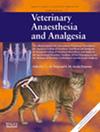Evaluation of an indirect NaV1.7 inhibitor as adjunctive analgesic in burn-related neuropathic pain in a cat
IF 1.9
2区 农林科学
Q2 VETERINARY SCIENCES
引用次数: 0
Abstract
Burn-related neuropathic pain (BRNP) can arise following burn-induced nerve damage, affects approximately 6% of burned human patients and can result in chronic pain. Although widely studied in humans, data on BRNP or its treatment in animals is lacking. A 4-year-old domestic shorthair cat was presented with an infected, non-healing wound suspected to be a caustic burn. Initial treatments included surgical debridement, antimicrobials, and corticosteroids, but the cat developed persistent pruritus leading to self-inflicted trauma. Despite various interventions, including prednisone, chloramphenicol and cyclosporine, clinical signs persisted, leading to a referral for suspected BRNP. Additional support for neuropathic pain was provided through thermal sensitivity testing and applying a modified Neuropathic Pain Symptoms Inventory. Treatment with gabapentin, amantadine, and acupuncture yielded little improvement, prompting an increasing escalation in gabapentin dosage. The cat was then treated with gabapentin compounded with compound 194, a small molecule that is a potent and selective inhibitor of voltage-gated sodium channel 1.7 (NaV1.7). The cat exhibited significant pain relief and improvements in overall condition. After gabapentin was tapered, compound 194 effectively maintained pain control. The cat’s clinical condition stabilized with no adverse effects. Hematology and serum biochemistry results remained within reference intervals throughout the treatment period. This case highlights the potential of NaV1.7 inhibitors in multimodal management of neuropathic pain in animals.
间接NaV1.7抑制剂作为猫烧伤相关神经性疼痛辅助镇痛的评价
烧伤相关神经性疼痛(BRNP)可在烧伤引起的神经损伤后出现,影响约6%的烧伤患者,并可导致慢性疼痛。尽管在人类中进行了广泛的研究,但缺乏关于BRNP或其在动物中的治疗的数据。一只4岁的家养短毛猫出现了一个感染的、未愈合的伤口,怀疑是腐蚀性烧伤。最初的治疗包括手术清创、抗菌剂和皮质类固醇,但猫出现了持续性瘙痒,导致自己造成的创伤。尽管采取了各种干预措施,包括强的松、氯霉素和环孢素,但临床症状持续存在,导致疑似BRNP的转诊。通过热敏测试和应用改良的神经性疼痛症状清单,为神经性疼痛提供额外的支持。加巴喷丁、金刚烷胺和针灸治疗效果甚微,促使加巴喷丁剂量不断增加。然后用加巴喷丁与化合物194混合治疗猫,化合物194是一种小分子,是电压门控钠通道1.7 (NaV1.7)的有效和选择性抑制剂。猫表现出明显的疼痛缓解和整体状况的改善。加巴喷丁逐渐减少后,化合物194有效地维持了疼痛控制。猫的临床状况稳定,无不良反应。血液学和血清生化结果在整个治疗期间保持在参考区间内。该病例强调了NaV1.7抑制剂在动物神经性疼痛多模式治疗中的潜力。
本文章由计算机程序翻译,如有差异,请以英文原文为准。
求助全文
约1分钟内获得全文
求助全文
来源期刊

Veterinary anaesthesia and analgesia
农林科学-兽医学
CiteScore
3.10
自引率
17.60%
发文量
91
审稿时长
97 days
期刊介绍:
Veterinary Anaesthesia and Analgesia is the official journal of the Association of Veterinary Anaesthetists, the American College of Veterinary Anesthesia and Analgesia and the European College of Veterinary Anaesthesia and Analgesia. Its purpose is the publication of original, peer reviewed articles covering all branches of anaesthesia and the relief of pain in animals. Articles concerned with the following subjects related to anaesthesia and analgesia are also welcome:
the basic sciences;
pathophysiology of disease as it relates to anaesthetic management
equipment
intensive care
chemical restraint of animals including laboratory animals, wildlife and exotic animals
welfare issues associated with pain and distress
education in veterinary anaesthesia and analgesia.
Review articles, special articles, and historical notes will also be published, along with editorials, case reports in the form of letters to the editor, and book reviews. There is also an active correspondence section.
 求助内容:
求助内容: 应助结果提醒方式:
应助结果提醒方式:


